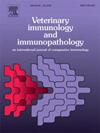马原生动物髓性脑炎(EPM)患者对神经元性肌囊炎的IgG应答分析表明存在th1偏向性免疫应答
IF 1.4
3区 农林科学
Q4 IMMUNOLOGY
引用次数: 0
摘要
马原虫性髓脑炎(EPM)是美洲马最重要的神经系统疾病之一。虽然马的神经索菌血清阳性率很高,但只有不到1%的感染马出现EPM的临床表现。死前诊断已被证明是具有挑战性的,因为血清中抗神经索细胞抗体是感染的指标,但不一定是疾病。控制EPM发生的因素在很大程度上是未知的,尽管马的免疫可能有助于EPM的发病机制。免疫球蛋白G是马血清中主要的抗体类别,由四个亚型组成;IgG1/2 (IgGa)和IgG4/7 (IgGb)被认为是Th1细胞介导的免疫应答的指示,IgG3/5 (IgG(T))和IgG6 (IgGc)被认为是Th2体液应答的指示。在这里,我们检验了EPM是由于异常免疫反应而发生的假设,这将被IgG亚型所识别。采用改良的ELISA法定量神经索细胞抗原特异性IgG亚型1/2、3/5和4/7。根据记录的血清IgG亚型浓度,使用21匹健康马的血清生成标准曲线,并在感染病马(n = 93)和感染正常马(n = 116)的血清和脑脊液中测定神经元s特异性IgG亚型水平。病马与正常马血清中IgG3/5的平均浓度和IgG1/2:IgG3/5对神经索菌的比值存在显著差异,表明EPM马对神经索菌的免疫反应倾向于Th1细胞介导的应答。不幸的是,这些差异不足以开发基于血清的EPM诊断免疫分析。本文章由计算机程序翻译,如有差异,请以英文原文为准。
Analysis of IgG responses to Sarcocystis neurona in horses with equine protozoal myeloencephalitis (EPM) suggests a Th1-biased immune response
Equine protozoal myeloencephalitis (EPM) caused by Sarcocystis neurona is one of the most important neurological diseases of horses in the Americas. While seroprevalence of S. neurona in horses is high, clinical manifestation of EPM occurs in less than 1 % of infected horses. Antemortem diagnosis has proven challenging as serum antibodies against S. neurona are an indicator of infection but not necessarily disease. Factors governing the occurrence of EPM are largely unknown, although horse immunity might contribute to EPM pathogenesis. Immunoglobulin G is the predominant antibody class in equine serum and consists of four subisotypes; IgG1/2 (IgGa) and IgG4/7 (IgGb) are thought to be indicative of a Th1, cell-mediated immune response, and isotypes IgG3/5 (IgG(T)) and IgG6 (IgGc) are thought to be indicative of a Th2, humoral response. Herein, we examined the hypothesis that EPM occurs due to an aberrant immune response, which will be discernable by IgG subisotypes. A modified ELISA was used to quantify S. neurona antigen-specific IgG sub-isotypes 1/2, 3/5, and 4/7. Based on documented serum concentrations of IgG subisotypes, standard curves were generated using sera from 21 healthy horses and S. neurona-specific IgG subisotype levels were determined in serum and cerebrospinal spinal fluid from infected diseased (n = 93) and infected normal (n = 116) horses. The mean IgG3/5 serum concentration and IgG1/2:IgG3/5 ratio against S. neurona were found to be significantly different between diseased and normal horses, suggesting that the immune response to S. neurona in EPM horses is skewed towards a Th1, cell-mediated response. Unfortunately, these differences were not sufficient for developing a serum-based immunoassay for EPM diagnosis.
求助全文
通过发布文献求助,成功后即可免费获取论文全文。
去求助
来源期刊
CiteScore
3.40
自引率
5.60%
发文量
79
审稿时长
70 days
期刊介绍:
The journal reports basic, comparative and clinical immunology as they pertain to the animal species designated here: livestock, poultry, and fish species that are major food animals and companion animals such as cats, dogs, horses and camels, and wildlife species that act as reservoirs for food, companion or human infectious diseases, or as models for human disease.
Rodent models of infectious diseases that are of importance in the animal species indicated above,when the disease requires a level of containment that is not readily available for larger animal experimentation (ABSL3), will be considered. Papers on rabbits, lizards, guinea pigs, badgers, armadillos, elephants, antelope, and buffalo will be reviewed if the research advances our fundamental understanding of immunology, or if they act as a reservoir of infectious disease for the primary animal species designated above, or for humans. Manuscripts employing other species will be reviewed if justified as fitting into the categories above.
The following topics are appropriate: biology of cells and mechanisms of the immune system, immunochemistry, immunodeficiencies, immunodiagnosis, immunogenetics, immunopathology, immunology of infectious disease and tumors, immunoprophylaxis including vaccine development and delivery, immunological aspects of pregnancy including passive immunity, autoimmuity, neuroimmunology, and transplanatation immunology. Manuscripts that describe new genes and development of tools such as monoclonal antibodies are also of interest when part of a larger biological study. Studies employing extracts or constituents (plant extracts, feed additives or microbiome) must be sufficiently defined to be reproduced in other laboratories and also provide evidence for possible mechanisms and not simply show an effect on the immune system.

 求助内容:
求助内容: 应助结果提醒方式:
应助结果提醒方式:


